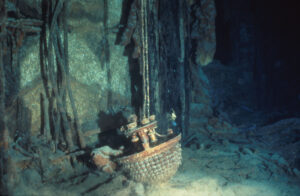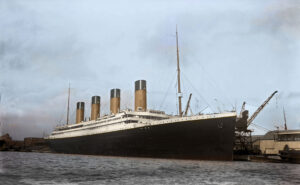Why Did the Titanic Sink? Details of a Disaster
 The RMS Titanic is one of the most famous ships in history. Its tragic sinking in 1912 continues to capture the world’s attention. Understanding how the Titanic sank helps us appreciate this maritime disaster’s impact. RMS Titanic Inc. plays a key role in preserving and exploring the Titanic wreck. This article covers the Titanic’s design, its maiden voyage, the events of the sinking, and RMS Titanic Inc.’s contributions to our understanding.
The RMS Titanic is one of the most famous ships in history. Its tragic sinking in 1912 continues to capture the world’s attention. Understanding how the Titanic sank helps us appreciate this maritime disaster’s impact. RMS Titanic Inc. plays a key role in preserving and exploring the Titanic wreck. This article covers the Titanic’s design, its maiden voyage, the events of the sinking, and RMS Titanic Inc.’s contributions to our understanding.
A Marvel of Modern Engineering
The Titanic represented the pinnacle of early 20th-century shipbuilding. Harland and Wolff, a renowned shipyard in Belfast, constructed this remarkable vessel. At 882 feet in length and 175 feet in height, the Titanic was one of the largest ships of its era.
The ship’s construction incorporated cutting-edge safety features. It had 16 watertight compartments designed to keep the vessel afloat even if multiple compartments were breached. Engineers also installed remotely activated watertight doors to seal off sections of the ship in case of an emergency. These safety measures led many to believe the Titanic was unsinkable.
The ship’s design also focused on luxury and comfort. The Titanic boasted opulent first-class accommodations, including grand dining rooms, a swimming pool, a gymnasium, and lavish staterooms. Second and third-class passengers also enjoyed better accommodations than typically found on other ships of the time. The attention to detail in both safety and luxury made the Titanic a symbol of modern engineering prowess and a testament to the ambition of its creators.
Despite these advanced features, the ship’s design had limitations. The watertight compartments did not extend high enough, and the rivets used in the hull were later found to be of lower quality. These factors contributed to the disaster that struck on its maiden voyage. The combination of innovative design and unforeseen vulnerabilities makes the Titanic’s story a compelling study in the triumphs and pitfalls of early 20th-century engineering.
Setting Sail: The Titanic’s Maiden Voyage

The Titanic’s maiden voyage began on April 10, 1912. It departed from Southampton, England, bound for New York City. The ship made stops in Cherbourg, France, and Queenstown, Ireland, to pick up additional passengers. On board were some of the wealthiest people of the era, as well as many emigrants seeking a new life in America. The voyage was smooth until the night of April 14, 1912.
Disaster Strikes: The Collision with the Iceberg
On the night of April 14, 1912, the Titanic’s lookouts, Frederick Fleet and Reginald Lee, spotted an iceberg directly in the ship’s path. They immediately rang the warning bell and telephoned the bridge. First Officer William Murdoch, in command at the time, ordered the ship to turn hard to port and the engines to be reversed. Despite these efforts, the Titanic struck the iceberg at 11:40 PM.
The impact caused a series of breaches along the starboard side below the waterline. These breaches spanned six of the ship’s forward watertight compartments. The ship’s design included watertight compartments meant to keep the vessel afloat even if four compartments were flooded. However, the damage exceeded this limit.
Water quickly poured into the breached compartments, causing the bow to start sinking. The crew, including Chief Officer Henry Wilde and Second Officer Charles Lightoller, worked to assess the damage and implement emergency procedures. They soon realized the ship’s fate. Captain Edward Smith, after evaluating the situation, ordered the lifeboats to be prepared and distress signals to be sent. The situation became dire as the enormity of the damage became apparent.
A Tragic Descent: The Sinking of the Titanic

The Titanic began its tragic descent shortly after the collision. The crew worked to assess the damage and implement emergency procedures. They sent distress signals using the Marconi wireless system, hoping for a swift rescue from nearby ships like the RMS Carpathia. Meanwhile, the evacuation of passengers began under the supervision of Captain Edward Smith and Second Officer Charles Lightoller. Lifeboats were launched, but many were only partially filled due to confusion and a lack of time.
The crew prioritized women and children, leaving many men on board. As the situation worsened, panic and chaos spread among passengers. At 2:20 AM on April 15, the Titanic broke apart and sank. The bow and stern sections separated and fell to the ocean floor. The area between them, now known as the debris field, is scattered with artifacts and personal items from the ship.
The events of that night were chaotic and tragic. Lifeboats launched in the freezing North Atlantic waters, where many passengers faced hypothermia. The crew continued to signal for help, and some nearby ships received the distress calls. However, help did not arrive in time to prevent the disaster.
The sinking of the Titanic marked a profound moment in maritime history, emphasizing the need for better safety regulations and practices. The legacy of this event continues to be studied and remembered, highlighting the human stories and engineering lessons from the tragedy.
Preserving History: The Role of RMS Titanic Inc.
RMS Titanic Inc. is dedicated to preserving the Titanic’s history. They hold exclusive rights to salvage artifacts from the wreck. Their missions aim to document, recover, and conserve items from the Titanic. This work helps to tell the story of the ship and its passengers. The company’s efforts provide valuable insights into the events of that fateful night.
Uncovering the Wreck: Key Discoveries by RMS Titanic Inc.

RMS Titanic Inc. has conducted several expeditions to the wreck site. They have recovered thousands of artifacts, including personal belongings and parts of the ship. These items offer a glimpse into life aboard the Titanic. Advanced technology, such as remotely operated vehicles (ROVs), allows for detailed exploration and documentation of the wreck. Photos and videos taken during these expeditions help researchers understand the ship’s condition and how it decayed over time.
Looking Ahead: The 2024 Titanic Expedition
The upcoming 2024 Titanic expedition aims to further explore and document the wreck site. RMS Titanic Inc. will use cutting edge technology to capture high-resolution images of the wreck. These new photos will help monitor changes and study the ship’s deterioration. The expedition will also seek to uncover and identify new artifacts and areas of the wreck. This mission is crucial for preserving the Titanic’s legacy and continuing research. The team will include experts in marine biology, archaeology, and deep-sea exploration.
Follow RMS Titanic Inc. for Updates on Their Next Expedition
Understanding how the Titanic sank is essential to preserving its legacy. The Titanic’s tragic end highlights the importance of maritime safety and the human stories connected to the disaster. RMS Titanic Inc. plays a critical role in exploring and preserving the ship’s history. Their work ensures that the story of the Titanic continues to educate and inspire future generations. Follow and support RMS Titanic Inc.’s mission and the 2024 expedition to help keep this important history alive.
